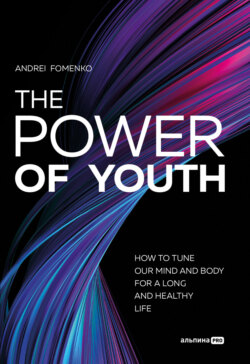Читать книгу The Power Of Youth. How To Tune Our Mind And Body For A Long And Healthy Life - Андрей Фоменко - Страница 23
CHAPTER 4
BODY
WHAT OUR BODY IS
ОглавлениеCELLS
The human body is made up of cells, the basic structural units, which work together and perform the various functions necessary to sustain life.
The human body weighing 70 kilograms consists of an average of 30 trillion cells. And most of them are erythrocytes – they account for 84 %. Then there are thrombocytes – 4.9 %, bone marrow cells – 2.5 %, vascular endothelial cells – 2.1 %, lymphocytes – 1.6 %, and hepatocytes – 0.8 %. Muscle and fat cells account for 0.1 % of the total cell number[42].
For the body to function properly, there is a continuous process of replacing old cells with new ones. About 3.8 million cells are renewed every second, and almost 330 billion cells per day. Even when a human dies, it will be a while before all the cells in the body die.
Researchers at the Karolinska Institute (Sweden), led by biologist Jonas Friesen, calculated the lifespan of individual cells, finding that they change differently – depending on the type[43]. For example, the epidermal cells that make up human skin are renewed every two weeks. Erythrocytes, which carry oxygen from the lungs to the tissues of the body, live for four months, while neutrophils, a type of white blood cell, live only for two days.
The life of liver cells is between 300 and 500 days. The epithelial cells lining the intestine last only five days and then are replaced by new cells – they are among the shortest-lived in the body. Without them, the average age of all intestinal cells is 15.9 years. Skeletal tissue cells live about 10 years, while cells of rib muscles live 15.1 years[44].
But not all cells are renewed: for example, the cells of the retina and lens do not change throughout life. This explains the natural deterioration of vision with age. For a long time, it was believed that nerve cells also live as long as humans, die with aging, and do not renew. However, recent data have shown that new neurons are formed from stem cells, but it is not yet known how functionally full-fledged they can be. Scientists estimate that the adult male brain contains 86.1 ± 8.1 billion neurons[45].
According to Friesen, the average lifespan of a human cell is 7–10 years. This statement has caused the popular misconception that "the human body renews every seven years." This is not true, because cell replacement is a continuous process: the body renews in different parts at different rates depending on the needs and functions.
ATOMS
At a more fundamental level, cells consist of molecules, which, in turn, consist of atoms (from Greek ἄτομος "uncuttable"). An adult human body weighing 70 kg contains about 6.7 octillion (6.7 × 1027) atoms, 96.5 % of which are chemical elements[46] such as hydrogen, oxygen, carbon, and nitrogen. About 4 % are other ones: calcium, phosphorus, sodium, potassium, sulfur, etc.[47].
Most of the chemical elements come from the environment. When we eat, drink, or breathe, atoms enter the body. They not only compose cellular structure but also ensure the flow of chemical processes, supporting vital activity.
When we exhale, sweat, or lose body tissues, i.e., excrete anything into the environment, the atoms return to the Earth's biosphere. From there they enter the bodies of other people, animals, and plants. Thus, most of the atoms in the body are constantly replaced. And they do it differently – some in a few hours, others in a few years.
All these atoms are not regenerated every day. They have been around for billions of years and existed long before the Earth was formed. The first atoms formed in the early days of the universe, 13.7 billion years ago, about 380,000 years after the Big Bang. By that time, the universe had already cooled enough for electrons and protons to combine and form hydrogen and helium. The first stars were born from these atoms, and because of nuclear reactions in them, other heavier elements were formed.
Every particle of our body was once inside such stars or was formed because of its death. "Every atom in your body came from a star that exploded. It is the most poetic thing I know about physics. And, the atoms in your left hand probably came from a different star than your right hand. You are all stardust," writes physicist Lawrence Krauss in his book "A Universe from Nothing."
42
Sender R., Fuchs S., Milo R. Revised Estimates for the Number of Human and Bacteria Cells in the Body. Published: August 19, 2016. doi:10.1371/journal.pbio.1002533.
43
Spalding K. L., Bhardwaj R. D., Buchholz B. A., Druid H., Frisén J. Retrospective Birth Dating of Cells in Humans. doi:10.1016/j. cell.2005.04.028PlumX Metrics.
44
Kong S., Zhang Y. H., Zhang W. Regulation of Intestinal Epithelial Cells Properties and Functions by Amino Acids. doi:10.1155/2018/ 2819154.
45
Azevedo F. A. C., Carvalho L. R. B., Grinberg L. T., et al. Equal numbers of neuronal and nonneuronal cells make the human brain an isometrically scaled-up primate brain. Published: 18 February 2009 doi:10.1002/cne.21974.
46
Chemical element is a type of atom that has certain chemical properties. The adult body consists of more than 60 chemical elements – Ed. note.
47
Alberts B., Johnson A., Lewis J., et al. Molecular Biology of the Cell. 4th edition. The Chemical Components of a Cell. https://www.ncbi.nlm.nih.gov/books/NBK26883/#A166.
